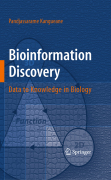
Bioinformation Discovery illustrates the power of biological data in knowledge discovery. It describes biological data types and representations with examples for creating a workflow in Bioinformation discovery. The concepts in knowledge discovery from data are illustrated using line diagrams. The principles and concepts in knowledge discovery are used for the development of prediction models for simulations of biological reactions and events. Advanced topics in molecular evolution and cellular & molecular biology are addressed using Bioinformation gleaned through discovery. Each chapter contains approximately 10 exercises for practice. This will help students to expand their problem solving skills in Bioinformation Discovery. Each chapter concludes with a number of good problem sets to test mastery of the material. Illustrates the power of biological data in knowledge discovery Used for the development of prediction models for simulations of biological reactions and events Examples of knowledge discovery with plenty of exercise problems INDICE: Introduction.- Creating datasets.- Tools and techniques.- Protein subunits interaction.- Homodimer folding and binding.- Fusion proteins.- Majorhisto-compatibility complex (MHC) and peptide binding.- HLA supertypes.- T-Epitope designer.- Eukaryotic genes, functions, genomes, design and evolution.
- ISBN: 978-1-4419-0518-5
- Editorial: Springer
- Encuadernacion: Cartoné
- Páginas: 275
- Fecha Publicación: 01/10/2009
- Nº Volúmenes: 1
- Idioma: Inglés
